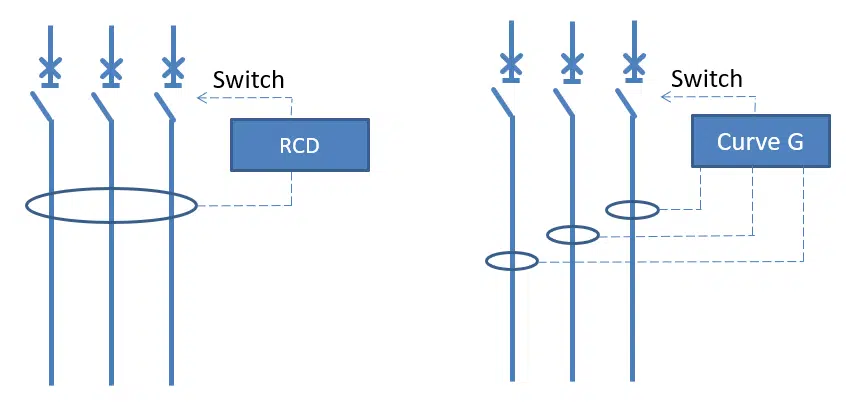Last edit: 10/05/2023
THE DOUBT
What are the differences between RCDs and Type G Ground Fault Protections?
CONSIDERATIONS
Among possible causes of electric shock there are the Indirect Contacts: following a Ground Fault, for example caused by defective insulation, the current can flow through an exposed conductive part, and a person may die in case he touches it.
Both type G and Residual Current Devices operate to protect against Indirect Contact (Fault Protection) and both act on the same principle. In a normal three-phase current distribution, the vector sum of the three phase currents (and of the neutral, if distributed) is zero. In the event of a ground fault, the phase involved in the failure undergoes a significant variation and we have a non-zero sum. Both types of protection act by keeping under control the vector sum of the Three phases (and the neutral, if distributed), interrupting the circuit when non-zero sum is occurs. So what's the difference?

The switches with Curve G (as in Ground Fault) work with electronic control: Moulded Case Circuit Breakers use phase TA to monitor the current to guarantee protection against overcurrents; these same phase TA, detecting the current for each phase and, separately, the voltage, recreate the current vectors and then calculate the vector sum: if the sum is not zero, the switch triggers. The phase TA are not extremely precise, and the calculation error could trigger the switch frequently if calibrated to low current value; to prevent unnecessary switch triggers, the sensibility of the G curve can be calibrated to values equal or higher than 0.2 In. Being an electronic instrument, it is very versatile, the intervention current and any scheduled delay can be programmed as needed.
Residual current devices, or RCDs, work through a physical measure of the 3 phases: the cables pass through a toroid, a not-zero sum triggers the switch and interrupts the circuit. This method of measurement is much more precise, and therefore allows you to rely on this type of protection for high sensibility applications, such as domestic use. Legislation imposes RCDs with sensibility of 30 mA for Europe, of 6 mA for North America. In this case too, manufacturers provide more complex models with changeable sensibility and activation times, to promote selectivity between plant protections, for example in the industrial sector.
CONCLUSION
RCDs and switches with curve G have the same objective, Fault protection, and the same basic principle, activation according to the variation of the vector sum of the currents. The differences are on the way of measuring the sum of currents, and on the sensibility to which they can operate.